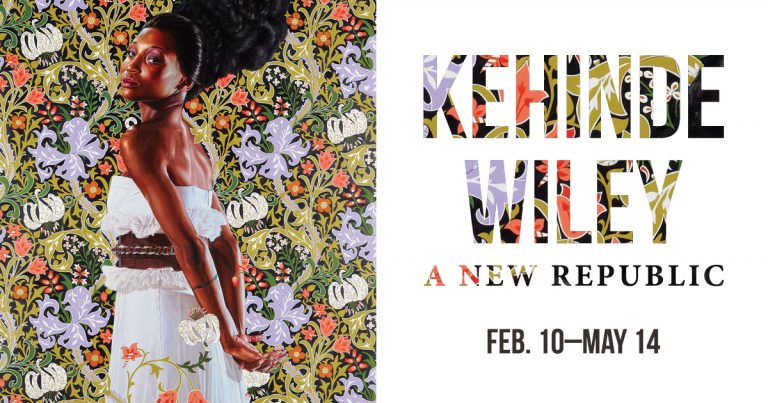“I am standing on the shoulders of all those artists who came before me, but here there is a space for a new way of seeing black and brown bodies all over the world” – Kehinde Wiley
Upon arrival to the Toledo Museum of Arts and promptly demonstrating my navigational incapability, I was kindly directed to the temporary exhibit just around the corner featuring the works of Kehinde Wiley. Near empty – my favorite way to experience museums – the gallery continued beyond my expectations, featuring a large number of works. Wiley’s portraits often reached from floor to ceiling, a daunting presence over the viewer. The pieces are beyond striking; Wiley’s characteristic style features portraits placed onto bright, almost cartoon-esque floral and geometric backgrounds that begin to creep over the bodies of the subjects. Wiley’s portraits feature men and women of color, often strangers he has approached on the street. Looking to the works of Old Master paintings for inspiration, Wiley allows the models to choose for themselves who they are modeled after, giving them authority within their representation. Wiley’s work encourages a discussion about the roles of race, gender, and religion within art. It was a strange experience to exit the world of Wiley the Toledo Museum created, only to enter into the next gallery featuring the same white, aristocratic portraits this exhibition critiqued.
Bound by Kehinde Wiley
Outside of the Wiley exhibit, the Toledo Museum of Art features a strong collection of pieces. One exhibit that struck me, to the point of gawking, was a gallery called “the Cloisters”. Set up as a medieval monastery, the ceiling can transition from “day” to “night”. Standing beneath an artificial night sky in the middle of an artificial monastery, the soft sounds of recorded monk chants filtered into space, is how all art should be experienced. The gallery and museum space almost fades away, no longer art on display, you begin to witness objects within their original context. A gallery featuring works of art that were all of different mediums, regions, and time periods particularly caught my museum-loving heart, as I don’t commonly see this in museums; it looked at what techniques made them similar or different, giving the visitor an art-history vocabulary and allowing them to be able to pick out the trends themselves.
I loved the progressive feel of the Museum. It offered chairs not merely for resting oneself from museum-exhaustion, but for pondering art in only the most immersive and slightly pretentious of manners. Technology was used in a way that enhanced the experience without encroaching upon the art itself (I admittedly did stand in line behind a group of not-quite-teenage girls for the photo booth). The Wiley exhibit featured two documentary-style videos that could have taken an afternoon to view in themselves.
Be Afraid of the Enormity of the Possible by Alfredo Jaar
Kehinde Wiley’s exhibit will be on display at the Toledo Museum of art until May 14. Whether you’re an art connoisseur or an art novice, this exhibition gives the viewer more to ponder than merely the visual, a timely and dynamic array of art.








